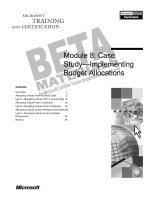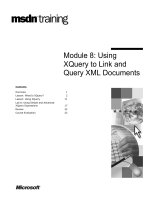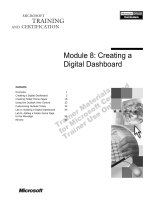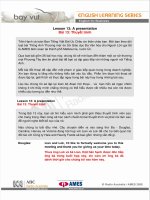Tài liệu Lesson 8: Class Inheritance ppt
Bạn đang xem bản rút gọn của tài liệu. Xem và tải ngay bản đầy đủ của tài liệu tại đây (41.81 KB, 4 trang )
Using Excellent Tools to Write Web Applications Targeting
the .NET Common Language Runtime (CLR)
[Home] [Up] [Lesson01] [Lesson02] [Lesson03] [Lesson04] [Lesson05
[Lesson06] [Lesson07] [Lesson08] [Lesson09] [Lesson10] [Lesson11
[Lesson12] [Lesson13]
On sale Now! C#
Unleashed is an in-
depth guide for
intermediate to
advanced software
developers to learn
the C#
programming
language and
serve as a desktop
reference.
.
.
.
.
.
.
.
.
.
.
The C# Station Tutorial
by Joe Mayo, 12/9/00, 12/8/01
Lesson 8: Class Inheritance
This lesson teaches about C# Inheritance. Our objectives are as follows:
l
Implement Base Classes.
l
Implement Derived Classes.
l
Initialize Base Classes from Derived Classes.
l
Learn How to Call Base Class Members.
l
Learn How to Hide Base Class Members.
Inheritance is one of the primary concepts of object-oriented
programming. It allows you to reuse existing code. Through effective
employment of reuse, you can save time in your programming.
Listing 8-1. Inheritance: BaseClass.cs
using System;
public class ParentClass
{
public ParentClass()
{
Console.WriteLine("Parent Constructor.");
}
public void print()
{
Console.WriteLine("I'm a Parent Class.");
}
}
public class ChildClass : ParentClass
{
public ChildClass()
{
Console.WriteLine("Child Constructor.");
}
Page 1 of 4Tutorial
6/24/2002 />
public static void Main()
{
ChildClass child = new ChildClass();
child.print();
}
}
Output:
Parent Constructor.
Child Constructor.
I'm a Parent Class.
Listing 8-1 shows two classes. The top class is named ParentClass and the
main class is called ChildClass. What we want to do is create a child class,
using existing code from ParentClass.
First we must declare our intention to use ParentClass as the base class of
ChildClass. This is accomplished through the ChildClass declaration "public
class ChildClass : ParentClass". The base class is specified by adding a
colon, ":", after the derived class identifier and then specifying the base
class name.
C# supports single class inheritance only. Therefore, you can specify only
one base class to inherit from.
ChildClass has exactly the same capabilities as ParentClass. Because of
this, you can also say ChildClass "is" a ParentClass. This is shown in the
Main() method of ChildClass when the print() method is called. Child class
does not have it's own print() method, so it uses the ParentClass print()
method. You can see the results in the 3rd line of output.
Base classes are automatically instantiated before derived classes. Notice
the output from Listing 8-1. The ParentClass constructor executed before
the ChildClass constructor.
Listing 8-2. Derived Class Communicating with Base Class: BaseTalk.cs
using System;
public class Parent
{
string parentString;
public Parent()
{
Console.WriteLine("Parent Constructor.");
}
public Parent(string myString)
{
parentString = myString;
Page 2 of 4Tutorial
6/24/2002 /> Console.WriteLine(parentString);
}
public void print()
{
Console.WriteLine("I'm a Parent Class.");
}
}
public class Child : Parent
{
public Child() : base("From Derived")
{
Console.WriteLine("Child Constructor.");
}
public new void print()
{
base.print();
Console.WriteLine("I'm a Child Class.");
}
public static void Main()
{
Child child = new Child();
child.print();
((Parent)child).print();
}
}
Output:
From Derived
Child Constructor.
I'm a Parent Class.
I'm a Child Class.
I'm a Parent Class.
Derived classes can communicate with base classes during instantiation.
Listing 8-2 shows how this is done at the child constructor declaration.
The colon, ":", and keyword base call the base class constructor with the
matching parameter list. The first line of output shows the base class
constructor being called with the string "From Derived".
Sometimes you may want to create your own implementation of a method
that exists in a base class. The Child class does this by declaring it's own
print() method. The Child print() method hides the Parent print method.
The effect is the Parent print method will not be called, unless we do
something special to make sure it's called.
Inside the Child print() method, we explicitly call the Parent print()
method. This is done by prefixing the method name with "base.". Using
the "base" keyword, you can access any of a base class' public or protected
class members. The output from the Child print() method is on output
lines 3 and 4.
Page 3 of 4Tutorial
6/24/2002 />Another way to access base class members is through an explicit cast.
This is done in the last statement of the Child class Main() method.
Remember that a derived class is a specialization of it's base class. This
fact allows us to perform a conversion on the derived class, making it an
instance of it's base class. The last line of output from Listing 8-2 shows
the Parent print() method was indeed executed.
Notice the "new" modifier on the Child class print() method. This enables
this method to hide the Parent class print() method, thus explicitly
preventing polymorphism. Without the "new" modifier, the compiler will
produce a warning to draw your attention to this. See the next lesson for
a detailed discussion of polymorphism.
In summary, you know how to create a derived/base class relationship.
You can control instantiation of your base class and call it's methods either
implicitly or explicitly. You also understand that a derived class is a
specialization of it's base class.
I invite you to return for Lesson 9: Polymorphism.
Your feedback is very important and I appreciate any constructive
contributions you have. Please feel free to contact me for any questions or
comments you may have about this lesson.
Feedback
C# Station
Copyright (c) 2002 C# Station
Page 4 of 4Tutorial
6/24/2002 />









